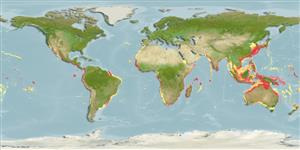Common names from other countries
Lớp phụ Cá sụn (cá mập và cá đuối) (sharks and rays) >
Myliobatiformes (Stingrays) >
Mobulidae (Devilrays)
Etymology: japanica: Named for Japan..
More on authors: Müller & Henle.
Issue
This species is considered as a junior synonym of Mobula mobular according to Last et al., 2016 (Ref. 114953) and White et al., 2017 (Ref. 115945:13). The species page will be removed,.
Environment: milieu / climate zone / depth range / distribution range
Sinh thái học
Biển Cùng sống ở rạn san hô; Mức độ sâu 0 - 647 m (Ref. 106604), usually 0 - 200 m (Ref. 89423). Subtropical; 40°N - 30°S
Indo-Pacific: off South Africa, the Arabian Sea eastward to the Hawaiian Islands and Polynesia. Eastern Pacific: on the continental coast. Eastern Atlantic: Côte d'Ivoire but may probably be more wide-ranging. This has to be critically compared with Mobula mobular of the Mediterranean Sea and nominally elsewhere in the North Atlantic.
Length at first maturity / Bộ gần gũi / Khối lượng (Trọng lượng) / Age
Maturity: Lm 217.8, range 204 - ? cm
Max length : 310 cm WD con đực/không giới tính; (Ref. 50641); 240.0 cm WD (female); common length : 225 cm WD con đực/không giới tính; (Ref. 9256)
Dark blue to black above, white below. Inner surface of cephalic fins silver grey with black tip, outer surface and side behind eye white (Ref. 11228). Shared characters between M. rancureli and Mobula japanica: teeth, placoid scales, and branchial filter morphologies, morphometrics, presence of tail spine, distinctive shape and coloration of dorsal fin, and general shape of body and coloration (Ref. 50641).
Found inshore, possibly in oceanic waters (Ref. 9911). Pelagic (Ref. 58302). Occurs singly or in groups (Ref. 9911). Feeds mainly on euphausiids (mainly Nictiphanes simplex), and to a lesser extent on copepods and crustacean larvae. May also feed on small fishes. Ovoviviparous (Ref. 50449). Acoustic tracks record the species to spend time above the thermocline at night to feed on krill (H. Dewar, pers.comm. 05/2000). Very common by-catch of the gillnet fisheries targeting skpjack tuna (Katsuwonus pelamis). Utilized for its gill filter plates (very high value), meat, cartilage and skin (Ref.58048).
Exhibit ovoviparity (aplacental viviparity), with embryos feeding initially on yolk, then receiving additional nourishment from the mother by indirect absorption of uterine fluid enriched with mucus, fat or protein through specialised structures (Ref. 50449). With one in a litter (Ref. 12951). Size at birth 85-92 cm WD (Ref. 12951, Ref.58048).
Last, P.R. and J.D. Stevens, 1994. Sharks and rays of Australia. CSIRO, Australia. 513 p. (Ref. 6871)
IUCN Red List Status (Ref. 130435)
Threat to humans
Harmless
Human uses
Các nghề cá: Tính thương mại
Các công cụ
Special reports
Download XML
Các nguồn internet
Estimates based on models
Preferred temperature (Ref.
115969): 17.5 - 29, mean 27.4 (based on 5840 cells).
Phylogenetic diversity index (Ref.
82804): PD
50 = 0.5005 [Uniqueness, from 0.5 = low to 2.0 = high].
Bayesian length-weight: a=0.01000 (0.00244 - 0.04107), b=3.04 (2.81 - 3.27), in cm Total Length, based on all LWR estimates for this body shape (Ref.
93245).
Mức dinh dưỡng (Ref.
69278): 3.4 ±0.43 se; based on food items.
Thích nghi nhanh (Ref.
120179): Rất thấp, thời gian nhân đôi của chủng quần tối thiểu là hơn 14 năm (Fec=1).
Fishing Vulnerability (Ref.
59153): High vulnerability (58 of 100).
